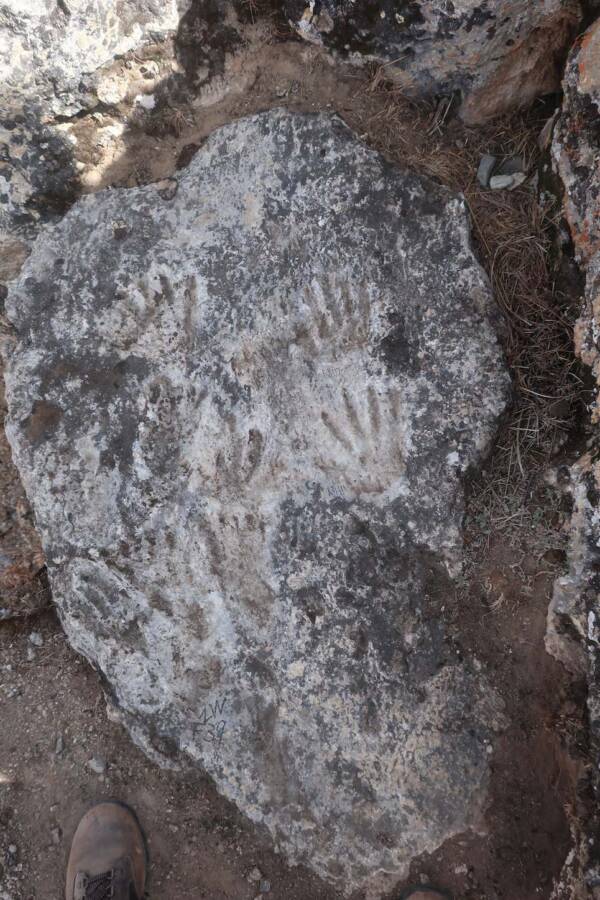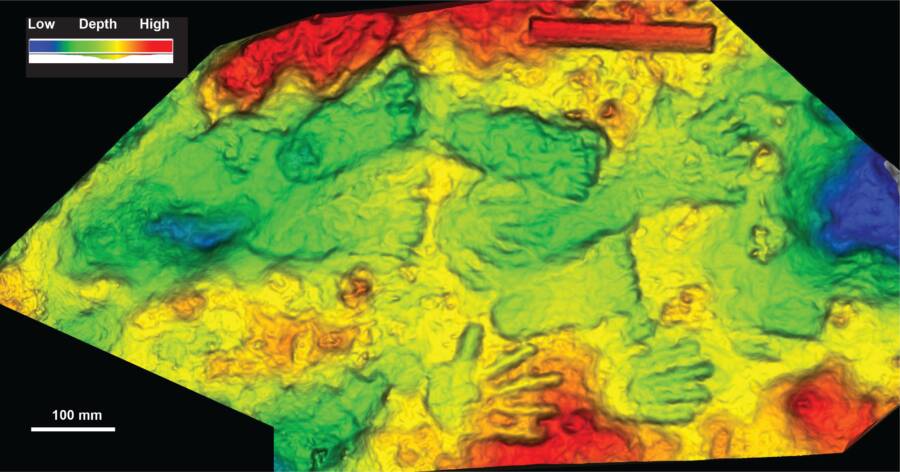Whether or not the handprints represent the oldest known art comes down to a difficult question — what is art?

D.D. Zhang et al.Archeologists suspect the prints were made 169,000 to 226,000 years ago by two young children.
Hundreds of thousands of years ago, two children pressed their hands into soft limestone in present-day Quesang, Tibet. As time passed, the limestone hardened, preserving their handprints. Now, some archeologists believe that this ancient echo of childhood play might represent the oldest human art ever found.
“The prints would not be simply byproducts of some other activity such as jumping or running,” explained Thomas Urban, an archeologist at Cornell University who co-authored a recent study on the prints. “They are a primary product — the printmaker was making the prints intentionally.”
The prints were first discovered on a boulder in Quesang in 2018. There, archeologists led by David Zhang found “five handprints and five footprints [which] appear to have been carefully placed.”
Based on data from the World Health Organization, archeologists determined that two children — one around 7 years old, the other closer to 12 — likely left the prints.

Cornell UniversityA 3D model of the prints shows their varying depths.
But it was the age of the prints that caught the team’s attention. By measuring the levels of uranium isotopes in the rock, they determined that the prints were between 169,000 and 226,000 years old.
That means that the prints might be the oldest human-made art ever discovered. They’re far older than the oldest known cave painting, which is about 64,800 years old.
“This would make the site the earliest currently known example of parietal [rock or cave] art in the world,” the archeologists explained in the journal Science Bulletin.
“This remarkable discovery adds to the body of research that identifies children as some of the earliest artists within the genus Homo.”
However, whether or not the handprints are the oldest art ever found depends on one difficult question. What is art?
“I find it difficult to think that there is an ‘intentionality’ in this design,” said Eduardo Mayoral, a paleontologist with the University of Huelva in Spain. “And I don’t think there are scientific criteria to prove it — it is a question of faith, and of wanting to see things in one way or another.”
And Michael Petraglia, an archaeologist and anthropologist at the Max Planck Institute for the Science of Human History in Jena, Germany, noted, “This is a very big claim.”
But to the archeologists who discovered the handprint, it’s clear — the handprints are art.
“It is the composition, which is deliberate, the fact the traces were not made by normal locomotion, and the care taken so that one trace does not overlap the next, all of which shows deliberate care,” explained Matthew Bennett, a geologist at Bournemouth University who co-authored the study.
His co-author, Urban, wholeheartedly agrees.
“The arrangement of the prints defies any practical explanation, such as walking, or any accidental explanation, such as falling,” Urban argued. “They appear to have been carefully arranged, implying a deliberate choice was made in placing them this way.”
Ultimately, however, the artist nature of the handprints is up to interpretation. Why did the children leave the prints? Were they scrambling over the boulder? Or did they press their hands into the limestone, hoping to leave a mark, as today’s children might do in wet cement?
If not art exactly, then at least the prints are a trace of an ancient time, and an ancient people. Left by children hundreds of thousands of years ago, they represent the faint thread of humanity that links modern society with its deep roots. In the words of two archeologists involved in the study:
“Whatever these humble traces represent, they clearly evoke images of children at high elevations, enjoying a spot of creative play.”
After reading about the discovery of what may be the earliest known human art, learn about the archeological discoveries that changed history. Or, see how archeologists in Australia came across the largest dinosaur footprint ever found.





